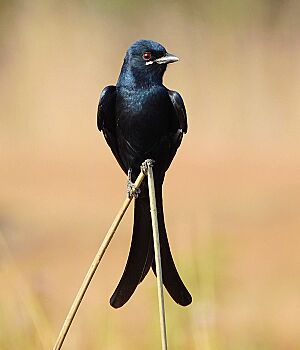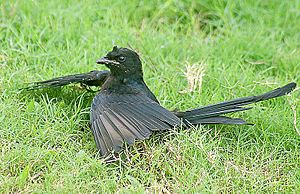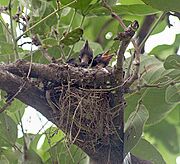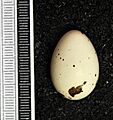Black drongo facts for kids
Quick facts for kids Black drongo |
|
|---|---|
 |
|
| Conservation status | |
| Scientific classification | |
| Genus: |
Dicrurus
|
| Species: |
macrocercus
|
| Subspecies | |
|
D. m. macrocercus (Vieillot, 1817) |
|
 |
|
| Approximate range
Breeding visitor Present year-round Winter visitor only |
|
| Synonyms | |
|
Buchanga atra |
|
The black drongo (Dicrurus macrocercus) is a small, shiny black bird. It belongs to the drongo family. You can find it across tropical southern Asia, from Iran to China and Indonesia. It's also an occasional visitor to Japan.
This bird is easy to spot because it's all black with a special forked tail. It grows to about 28 cm (11 inches) long. Black drongos love to eat insects. They are often seen in open fields and light forests. They like to perch on bare branches or power lines, watching for their next meal.
Black drongos are known for being very brave and aggressive. They will attack much larger birds, like crows or birds of prey, if they come too close to their home. This fearless behavior earned them the nickname "king crow." Smaller birds sometimes build their nests near a black drongo's nest because they know the drongo will protect them.
The black drongo is listed as a species of "least concern" by the International Union for Conservation of Nature (IUCN). This means it's not currently in danger of disappearing. It's common and lives in a very wide area. However, black drongos were brought to some Pacific islands. There, they have become very common and have affected the native bird species.
Contents
What is a Black Drongo?
The black drongo is a type of passerine bird. This means it's a perching bird, like sparrows or robins. It was once thought to be the same species as the African fork-tailed drongo. But now, scientists know they are different species. The fork-tailed drongo lives only in Africa, while the black drongo lives in Asia.
How to Identify a Black Drongo
This bird is completely glossy black. It has a wide, forked tail, which is its most famous feature. Adult drongos usually have a small white spot near the base of their beak. Their eyes are dark brown. It's hard to tell males and females apart just by looking at them.
Young drongos are brownish. They might have some white spots on their belly. They can sometimes be confused with other drongo types.
Brave and Fearless Birds
Black drongos are very brave and fearless. Even though they are only about 28 cm (11 inches) long, they will attack much bigger birds. This includes crows and birds of prey that fly into their nesting area. This is why they were once called "king crow."
They fly with strong wing beats. They can move very fast in the air to catch flying insects. They have short legs, so they sit upright on branches, bushes, or electric wires. Sometimes, they even perch on grazing animals like cows.
Black drongos make many different sounds. A common call sounds like "tee-hee."
Where Black Drongos Live
Black drongos mostly live in open areas. They often perch and hunt close to the ground. They are mainly insect hunters that catch bugs in the air. But they also pick insects off the ground or from plants.
They are summer visitors to parts of Afghanistan and Pakistan. But they live year-round in India, Sri Lanka, and Bangladesh. Some groups of drongos move around during different seasons. Black drongos can be found in savannas, fields, and even cities.
Drongos in New Places
Black drongos were brought to the island of Rota in the Pacific Ocean. This happened just before World War II. People hoped they would help control insects there. It's thought that they flew across the sea to the island of Guam in the 1950s.
By the 1960s, they were one of the most common birds on Guam. Today, they are the most common bird there. Their presence has affected native bird species on these islands.
Black Drongo Behavior
What They Eat and How They Hunt
Black drongos wake up early and stay active later than many other birds. They mainly eat insects. Their diet includes grasshoppers, termites, bees, ants, moths, and beetles. Sometimes, they fly close to tree branches to scare out hidden insects.
They gather in fields where farmers are plowing. This is because plowing brings up caterpillars and beetle grubs from the ground. Many drongos can be seen together at these times. They are also drawn to fires in grasslands. Fires disturb insects, making them easier to catch.
Drongos often hunt near other birds like common mynas and cattle egrets. These birds share similar diets and habitats. Drongos benefit from this, as they find more food when hunting with these birds. Sometimes, a drongo might even steal food from a myna. It's said they might even copy the call of a shikra bird to scare mynas away and then steal their prey.
Black drongos have also been seen eating small birds, reptiles, or even bats. They might eat more birds when they are migrating. They can even hunt insects attracted to artificial lights at night.
Nesting and Raising Young
Black drongos usually breed from February to March in southern India. In other areas, they breed until August. During this time, males and females sing in the mornings. Their courtship can involve flying chases. They might even lock their wings and beaks together while falling to the ground.
The nest is shaped like a cup. It's made of thin sticks and built in the fork of a tree branch. Both parents build the nest in about a week. They usually lay three or four eggs. The eggs are pale cream to red with spots. They are about 26 mm (1 inch) long. Both parents take turns sitting on the eggs. The eggs hatch after 14 to 15 days.
Young drongos are cared for by their parents. If the first nest is destroyed, they might lay eggs again. Sometimes, older siblings from a previous brood help feed the new young birds.
Protecting Their Nests
Black drongos are known for chasing away predators from their nests. This behavior encourages other birds to nest nearby. Birds like orioles, doves, and bulbuls often build their nests close to a drongo's nest. They know the drongo will protect them from danger.
Young drongos have yellowish-red mouths when they are born. Their eyes open after about eight days. The young birds leave the nest when they are about 16 to 20 days old. They don't have their forked tail until they are about three weeks old. Their parents continue to feed and protect them for about a month. Young birds learn to fly and hunt during this time.
Drongos are so aggressive that they might even land on large birds of prey and peck them when chasing them away. They have also been seen playing by dropping a leaf in the air and catching it. This might help young birds practice their flying skills.
Black Drongos and People
Black drongos are very common. They have many different local names. For example, in Hindi, they are called "Kotwal," which means "policeman." This name comes from their protective nature.
Sometimes, drongos can be a problem for bee-keepers because they eat bees. But farmers like them because they eat many pest insects. Farmers sometimes put up artificial perches in their fields to attract drongos. This helps the drongos eat more bugs that might harm crops.
In some parts of India, there's a belief that if a young drongo lands on a cow's horn, the cow will lose its horn. In other areas, they are respected.
Images for kids
-
In flight, Nepal.








